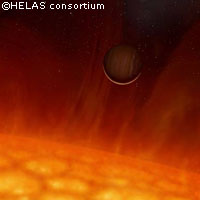Distant planet gives hint to Earth's fate
For the first time, astronomers have discovered a planet orbiting a star which is coming to the end of its life, in a study which offers clues regarding the eventual fate of our own planet. The study, which was partly funded by the EU and brought together scientists from 12 countries, is published in the latest edition of the journal Nature. The star in question, V 391 Pegasi, is found in the constellation Pegasus, and its 10 billion year old planet, named V 391 Pegasi b after its star, is one of the oldest ever found. However, according to lead researcher Roberto Silvotti of the Italian National Institute for Astrophysics, the planet's discovery came about almost by chance. 'We did know that in principle we could find a planet as it is commonly believed that about 5% of stars have planets, but our primary goal was different: to study the periodicity of the light emission of V 391 Pegasi,' he explained. Studying these pulsations, which have periods of several minutes, provides astronomers with information on the structure of the star. The scientists were surprised to notice irregularities in the planet's brightness which could be caused by a planet. For seven years, they carried out observations and computations to rule out other possible causes before coming to the conclusion that the irregularity was indeed caused by a planet which must have somehow survived the red giant stage of its star. When a star runs out of hydrogen fuel it undergoes an enormous expansion during which its volume increases by a factor of a few millions and the outer layers of the star are expelled in a 'helium flash'. During this 'red giant' stage, inner planets often become engulfed by the star. 'The exciting thing about finding a planet around this star is that it indicates that planetary systems can survive the giant phase and the helium flash of their parent star,' commented Steve Kawaler of Iowa State University, one of the authors of the paper. Of particular interest to the astronomers is the fact that prior to the star's expansion, the planet orbited the star at a similar distance that the Earth orbits our sun. So does this mean our planet will survive when, in around five billion years time, our own sun runs out of fuel and becomes a red giant? The scientists aren't sure. According to Professor Kawaler, while the findings bode well for the Earth, we shouldn't take too much heart in this. 'This planet is larger than Jupiter,' he pointed out. 'So a smaller planet like the Earth could still be vulnerable.' 'As far as our planets are concerned, we expect Mercury and Venus to disappear in the Sun's envelope, whereas Mars should survive,' added Dr Silvotti. 'The fate of the Earth is less clear because its position is really at the limit: it appears more likely that the Earth will not survive the red giant expansion of the sun either, but it is not for sure.' In an accompanying article, Jonathan Fortney of the NASA Ames Research Centre points out that the findings have implications for our understanding of planetary systems. 'If searches around evolved pulsating stars such as B subdwarfs and around still older, more-compact white dwarfs yield more planets, astronomers will be on the way towards understanding how stellar evolution affects the architecture of planetary systems,' he writes. 'This will shed light not only on our own Solar System, in which Mercury, Venus and perhaps Earth will eventually be engulfed by the red-giant Sun, but also on the diverse array of planetary systems that are our galactic neighbours.' EU support for the project came from the Sixth Framework Programme HELAS (European Helio- and Asteroseismology Network) project, which is funded under the 'Research infrastructures' priority.



